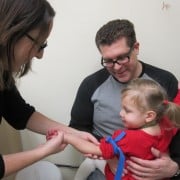Celiac Disease and Risk of Non-Hodgkin’s Lymphoma
 Here’s what we know so far about the link between celiac disease and NHL.
Here’s what we know so far about the link between celiac disease and NHL.
Researchers think that people with celiac disease are at an elevated risk of developing some types of cancer, like non-Hodgkin’s lymphoma (NHL).
They’re also at a higher risk of developing a rare but aggressive type of NHL called enteropathy-associated T-cell lymphoma (EATL).
- by Daniel Yetman, Medically reviewed by Teresa Hagan Thomas PHD, BA, RN in healthline.com 1
Celiac disease is an autoimmune condition triggered by eating the protein gluten. Gluten is found in wheat, rye & barley.
It’s estimated that about 2 million people in the United States have celiac disease, but many of these people have not been diagnosed yet.
When people with celiac disease eat gluten, their immune system responds by attacking their small intestine. This immune reaction damages the finger-like projections called villi along the small intestine. Damage to villi interferes with the body’s ability to absorb nutrients.
What is the association between celiac disease and non-Hodgkin’s lymphoma?
The majority of people with celiac disease have an excellent outlook if they adopt a gluten-free diet. However, researchers think that people with celiac disease are at an increased risk of developing some types of cancer, including NHL.
The majority of people with celiac disease do not develop cancer, and research suggests the increased risk is small.
Celiac disease and cancer
According to a 2021 literature reviewTrusted Source, many studies have examined the link between celiac disease and cancer.
Some studies in the literature review found that people with celiac disease have a greater risk of developing cancer, while other studies found no difference between the risk of cancer for people with celiac disease and the general population.
A large 2022 study in Sweden found that a group of 47,241 people with celiac disease developed cancer slightly more often than people without celiac disease.
The researchers reported that in a given year, around 6.5 out of every 1,000 people with celiac disease developed cancer, compared with 5.7 out of every 1,000 people in the general population.
The researchers found the risk of developing cancer was only significantly higher in the first year after receiving a celiac disease diagnosis, and only in people over the age of 40. People diagnosed with celiac disease after the age of 60 were at the highest risk.
Celiac disease and non-Hodgkin’s lymphoma
Early studies estimated people with celiac disease were 100 times more likely to develop lymphoma, but this number is now estimated to be much lower. Most studies now report a 3 to 12 times higher risk of all types of NHL and a 16 to 40 times higher risk of gut lymphomas.
Almost all studies in the literature review have found that the risk of dying from lymphoma is higher in people with celiac disease.
In a large 2020 study from Finland, researchers found that people with celiac disease had a 2.36 times higher chance of dying from lymphoma than the general population.
Celiac disease and enteropathy-associated T-cell lymphoma
A small number of people with celiac disease, about 1 to 2 percent, develop refractory celiac disease.
Refractory celiac disease is when celiac disease does not respond to at least 12 months of treatment with a gluten-free diet. It’s associated with a rare form of NHL called enteropathy-associated T-cell lymphoma (EATL).
EATL is an aggressive type of lymphoma with a poor prognosis, and it develops in the intestines. The vast majority of cases of EATL develop from refractory celiac disease.
Why do researchers believe celiac disease increases the risk of NHL?
Lymphoma starts in a type of white blood cell called lymphocytes. Your body contains lymphocytes in the lining of your intestines.
According to the American Cancer Society,Trusted Source it’s thought that the over activation of the immune system in autoimmune diseases like celiac disease might make lymphocytes grow and divide more often than normal, increasing their risk of becoming cancerous.
In a 2016 study, researchers examined the risk of cancer in first degree relatives of people with celiac disease. They found that first degree relatives were not at an elevated risk of cancer. This suggests that shared genes likely do not explain the risk of lymphoma in people with celiac disease.
The presence of certain genes may play a role in the development of EATL in people with refractory celiac disease. In a 2022 study, researchers found strong evidence that mutations in the JAK1-STAT3 pathway are the main drivers of lymphocytic changes.
What can you do to lower your risk of non-Hodgkin’s lymphoma?
If you have celiac disease, it’s important to avoid eating gluten. Even eating small amounts of gluten can trigger symptoms.
In the 2022 Swedish study, researchers found that the risk of celiac disease was only highest in the first year after diagnosis. The researchers note that this may be because switching to a gluten-free diet could help reduce the risk.
In a 2022 review, researchers found evidence that in people with celiac disease, not following a gluten-free diet increases the risk of developing cancer. However, more research is needed to fully understand the link.
Many of the other risk factors for developing NHL are largely out of your control.
According to the American Cancer Society, some studies suggest that having overweight or obesity increases your risk of NHL. Eating a balanced, nutritious diet and exercising regularly may help reduce your chances of developing lymphoma.
What are the early symptoms of non-Hodgkin’s lymphoma?
NHL can cause many different symptoms depending on:
- where the cancer develops in your body
- how advanced it is
- which subtype you have
You may not have any symptoms until the cancer grows to be large.
Some of the most common signs and symptoms include:
- swollen lymph nodes
- chills
- fatigue
- unintentional weight loss
- swollen abdomen
- loss of appetite
- chest pain
- shortness of breath
- cough
- more frequent or severe infections
- easy bruising and bleeding
NHL symptoms can also include “B symptoms,” which play an important role in staging lymphoma. These are:
- fever
- drenching night sweats
- unintentionally losing at least 10 percent of your body weight over 6 months
Some of the symptoms of NHL, like fatigue and weight loss, can also be signs of celiac disease. The main symptoms of EATL are gut problems like diarrhea and stomach pain, which can also mimic celiac disease.
It’s important to visit your doctor any time you develop new or worsening symptoms. Your doctor can help determine the underlying cause.
Takeaway
Researchers have found that people with celiac disease develop some types of cancer, like NHL, more often than people in the general population. However, most people with celiac disease do not develop cancer.
You can minimize your chances of developing celiac complications by sticking to a gluten-free diet. The outlook for most people with celiac disease is excellent when they avoid gluten.
A small number of people with celiac disease continue to have symptoms even while on a gluten-free diet. If you fall into this category, your doctor can help you develop an alternative treatment plan.
1 https://www.healthline.com/health/lymphoma/celiac-and-non-hodgkins-lymphoma












